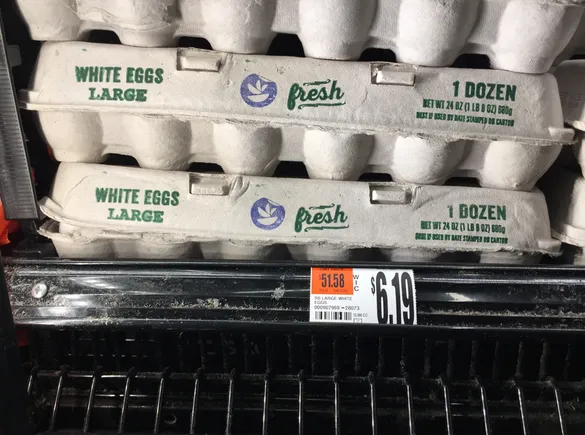Emma Ignaszewski is the director of corporate engagement at the Good Food Institute. Opinion’s are the author’s own.
Easter equals egg hunts. Every year as kids, my fiercely competitive sister and I embarked on an egg hunt in our Phoenix backyard. Even as teenagers, we continued the tradition to see who could find more.
Families across the country may face a hiccup with their annual egg hunt this April: three years into the current Avian flu outbreak, our access to eggs is unpredictable and even unaffordable. And this reality is unlikely to change anytime soon: volatile prices and limited supply are here to stay.
It’s time food companies planned for the recurring risk of Avian flu and recognized that egg price volatility isn’t just a fluke, it’s a pattern. Avian flu outbreaks and the resultant supply insecurity have happened before, in 2014-2015, 2022-2023, and at different times in regions around the globe. Since 2022, more than 160 million birds have died or been culled to contain the virus, and egg prices have nearly tripled. Prolonged price spikes and supply chain disruptions underscore the fragility of our food system, leaving consumers and businesses vulnerable to unpredictable costs.
There are dozens of ways American families use eggs, and even more ways American companies incorporate eggs into the products we buy at grocery stores and restaurants. People view eggs as a perfectly packaged, convenient source of protein. As an industry expert who studies consumer behavior and trends, I can tell you that egg demand isn’t going down anytime soon. But the traditions and stability of American egg consumption are under threat–revealing an opportunity for food companies.
Maybe it’s time to stop putting all our eggs in one basket. One solution? Egg alternatives.
Today, plant-based egg sales in U.S. grocery stores make up less than 0.5% of overall egg sales, signaling massive room for growth. About 30 percent of U.S.-produced eggs are used as ingredients in commercially baked goods and pastas, meaning food manufacturers have a unique opportunity to explore alternatives that can deliver the functionality of eggs (think binding and foaming) without impacting the consumer experience.
Plant-based egg ingredients are already widely available—and growing—thanks to versatile applications, consumer interest in allergen- and animal-free products, and (in some cases) cost advantages. There are a diversity of egg replacement options that fit a range of needs, made from chickpea flour, soy, mung bean protein, canola protein, aquafaba, tapioca flour, and even duckweed. Plant-based egg replacements offer affordability, convenience, and stability—some estimates show that switching can reduce relevant costs by as much as 30 percent.
New ingredient solutions are also on the horizon. Innovations like precision fermentation produce ingredients that are functionally the same as animal proteins, without requiring any animals (who, of course, are vulnerable to zoonotic diseases like avian flu). The process uses organisms such as yeast to produce ingredients like the same proteins found in eggs and dairy. Such proteins enable cheese to melt and stretch and give eggs their binding capabilities. This approach has a long history of safe use in food—over 80% of rennet used in cheese production is made this way. Several companies and ingredient manufacturers are innovating in precision-fermented dairy and eggs. Dairy-free mozzarella on pizza and omelettes made with plant-based eggs are already on some restaurant menus.
A new report from McKinsey highlights the supply chain benefits of fermentation-enabled proteins and estimates the market for these products could be $150 billion by 2050. The report notes many benefits: “increasing geographic flexibility and reducing exposure to weather, supply chain, and disease-related disruptions in the traditional food and agriculture value chain.” For consumers, this means a reliable supply of plant-based eggs, milk, cheese, baked goods, pastas, and more, without being impacted by conventional egg price spikes or shortages.
Of course, reformulation involves more than simply swapping eggs with alternatives. It requires careful ingredient selection and testing, technical feasibility assessments, supply chain adjustments, and production scale-up.
But these are all surmountable challenges. Some large food companies are already investing in egg alternatives to future-proof supply chains against disruptions and price shocks. In fact, the five largest U.S. food ingredient suppliers all have egg-replacement ingredients in their portfolios. And food giants like Unilever, Nestle, and Bel Brands have added ingredients made via precision fermentation (mainly dairy proteins) to products in their branded lines. For example, Bel Brands partnered with the precision-fermentation company Perfect Day to make Nurishh cream cheese alternative, which is lactose-free and contains whey protein from fermentation.
Plant-based and precision fermentation-derived ingredients offer manufacturers a smart hedge against supply chain shocks. They can help future-proof operations, offering a reliable, cost-stable, and sustainable choice. They can ensure business continuity and increased affordability for companies and consumers alike. And they can provide relief during surges of demand by families like mine who may celebrate Easter or observe Passover.
Companies who rethink their egg ingredient mix today will be better equipped to weather the disruptions of tomorrow.





